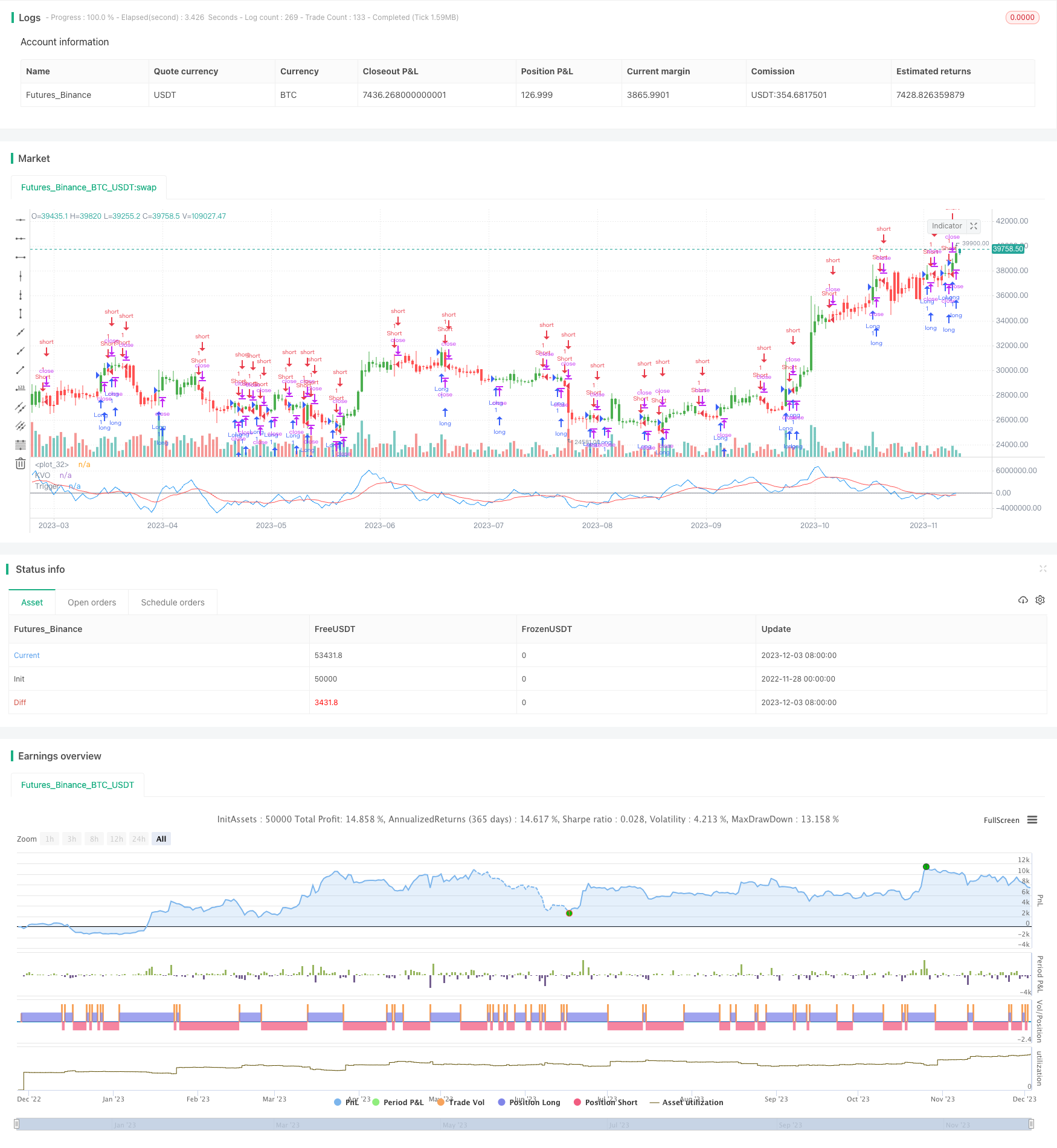トラフィック主導の振動定量戦略

これは,クリンガー定量指数に基づく取引戦略である.この戦略は,価格変動における買賣力の変化を捉え,市場動向の転換点を発見する.この戦略の優点は,敏さと正確さであり,短期と長期の分析に同時に適用できるということです.しかし,注意すべきリスクもあります.
戦略原則
この戦略は以下の理論に基づいています.
- 価格の範囲 ((最高価格 - 最低価格) は価格の変動幅を反映し,取引量は価格の変動の動力である.
- 当日の最高価格+最低価格+閉盘価格の和は前日より大きい,つまり買い手の力が増えた,蓄積した特性を表す;反対に分配された特性を表す。
- 取引量の継続的な変化は,取引相手の力の変化を反映しています.
これらの理論に基づいて,この戦略は,閉店価格の合計と前日の大きさの関係を比較し,取引量の変化を合成して,Klinger定量指数を計算する.指数が自分の均線を横切るときは多し,横切るときは空にする.
具体的には,この戦略には以下の3つの指標が組み込まれています.
- xTrend: 価格変動の強さを反映した,当日の終盤価格の合計と前日の比較に基づいたトレンド
- xFast:xTrendの急速平均線,パラメータは34日。
- xSlow:xTrendの遅い平均速度線,パラメータは55日。
差値xKVOを取引指数として計算する. 13日平均線xTriggerを上に乗せるときは多し,下に乗せるときは空にする.
戦略的優位性
この戦略の最大の利点は,短期と長期の分析を同時に行うことです. 素早い平均線のパラメータ設定は,短期トレンドの変化を敏感に捉えることを可能にします. 同時に,短期市場のノイズをフィルターして長期のトレンドを捉えることもできます. これは,多くの指標が価格を追跡するだけでは難しいことです.
さらに,この戦略は価格と取引量のみをベースに計算する.複雑な数学的指標を計算する必要がなく,計算効率が高く,実用的なアプリケーションに適している.
リスクと対策
この戦略の最大のリスクは,取引量指標が偽の突破を識別する能力が弱いことである. 価格が短期的に上方修正され平均線を破るとき,この戦略は誤った多重信号を発信する可能性がある. このとき,他の要因と組み合わせてトレンドを判断する必要がある.
さらに,この戦略はパラメータ設定に敏感である. 遅い平均線と取引平均線のパラメータは,最適なパフォーマンスを得るために繰り返しテストされ,最適化する必要があります.
戦略の最適化
リスク分析により,この戦略をさらに最適化できる点は以下の通りです.
損失の止まりの仕組みを増やす. 価格が一定比率に下がった時に損失の退出を止めて,短期的な調整の騒音干渉を減らすことができる.
トレンドフィルタリング指標を追加する.MACDなどの指数と組み合わせた移動平均指標は,市場の全体的な動きを判断し,振動的な状況で方向を間違わないようにする.
パラメータ設定の最適化 戦略の安定性を向上させるため,過去回測データから最適なパラメータの組み合わせを探します.
前期資金管理の最適化.例えば,止損状況に応じてポジションを動的に調整する.
要約する
この戦略は,価格の総量と取引量の関係を比較し,市場の買賣力の変化を捉え,同時に,感度と安定性を兼ね備えています.最適化パラメータを設定し,トレンド判断を組み合わせた前提で,良いパフォーマンスを得ることができます.しかし,トレーダーは,指標自体の限界がもたらすリスクに警戒する必要があります.
||
This is a trading strategy based on the Klinger Volume Oscillator. It captures the shifts in buying and selling forces during price fluctuations to identify turning points in market trends. The advantages are sensitivity and accuracy for both short-term and long-term analysis. However, some risks need to be noticed.
Strategy Logic
The strategy is built on the following assumptions:
- The price range (high-low) reflects the amplitude of price swings, while volume is the driving force behind price movements.
- If today’s sum of high + low + close is greater than yesterday’s, it indicates strengthened buying forces and accumulation; the opposite suggests distribution.
- Continuous changes in volume reflect shifts in the forces of buyers and sellers.
Based on the theories, the strategy calculates the Klinger Volume Oscillator by comparing the relationship between today’s sum of closing prices and yesterday’s, combined with changes in volume. It goes long when the indicator crosses above its moving average line, and goes short on crosses below.
Specifically, there are three main indicators involved:
- xTrend: reflects the force of price trend based on comparison of sum of prices between days.
- xFast: fast EMA of xTrend with period of 34.
- xSlow: slow EMA of xTrend with period of 55.
The difference xKVO is then calculated as the trading indicator. Go long on crossing above 13-day EMA xTrigger, and short on crossing below.
Advantages
The greatest advantage is being suitable for both short-term and long-term analysis simultaneously. The fast and slow EMA settings make it sensitive to catch short-term swings, while also filtering out market noise and capturing long-term trends, which most price-based indicators struggle with.
In addition, it is purely based on price and volume data without complex math. This makes it highly efficient for actual trading applications.
Risks & Solutions
The main risk is weaker ability to distinguish false breakouts. Short-term price adjustments may generate wrong long signals. Other factors should be considered to determine the trend.
Also, the strategy is sensitive towards parameter tuning. Optimization is required on the EMAs and trigger line to find best performance.
Strategy Optimization
Some aspects that could further optimize the strategy according to the risks:
Add stop loss mechanisms. Exiting at some percentage retracement reduces noise interference.
Add trend filtering with indicators like MACD to avoid directional mistakes in ranging markets.
Optimize parameter sets through backtests to improve robustness.
Capital management optimization such as dynamic position sizing based on stop loss/take profit levels.
Conclusion
Overall, the strategy captures shifts in market forces by comparing price quantities and volumes for both sensitivity and stability. It can perform well given optimized parameters and trend validation, but inherent limitations of volume indicators can still pose risks for traders.
[/trans]
/*backtest
start: 2022-11-28 00:00:00
end: 2023-12-04 00:00:00
period: 1d
basePeriod: 1h
exchanges: [{"eid":"Futures_Binance","currency":"BTC_USDT"}]
*/
//@version=2
////////////////////////////////////////////////////////////
// Copyright by HPotter v1.0 30/08/2017
// The Klinger Oscillator (KO) was developed by Stephen J. Klinger. Learning
// from prior research on volume by such well-known technicians as Joseph Granville,
// Larry Williams, and Marc Chaikin, Mr. Klinger set out to develop a volume-based
// indicator to help in both short- and long-term analysis.
// The KO was developed with two seemingly opposite goals in mind: to be sensitive
// enough to signal short-term tops and bottoms, yet accurate enough to reflect the
// long-term flow of money into and out of a security.
// The KO is based on the following tenets:
// Price range (i.e. High - Low) is a measure of movement and volume is the force behind
// the movement. The sum of High + Low + Close defines a trend. Accumulation occurs when
// today's sum is greater than the previous day's. Conversely, distribution occurs when
// today's sum is less than the previous day's. When the sums are equal, the existing trend
// is maintained.
// Volume produces continuous intra-day changes in price reflecting buying and selling pressure.
// The KO quantifies the difference between the number of shares being accumulated and distributed
// each day as "volume force". A strong, rising volume force should accompany an uptrend and then
// gradually contract over time during the latter stages of the uptrend and the early stages of
// the following downtrend. This should be followed by a rising volume force reflecting some
// accumulation before a bottom develops.
//
// You can change long to short in the Input Settings
// Please, use it only for learning or paper trading.
////////////////////////////////////////////////////////////
strategy(title="Klinger Volume Oscillator (KVO)", shorttitle="KVO")
TrigLen = input(13, minval=1)
FastX = input(34, minval=1)
SlowX = input(55, minval=1)
reverse = input(false, title="Trade reverse")
hline(0, color=gray, linestyle=line)
xTrend = iff(hlc3 > hlc3[1], volume * 100, -volume * 100)
xFast = ema(xTrend, FastX)
xSlow = ema(xTrend, SlowX)
xKVO = xFast - xSlow
xTrigger = ema(xKVO, TrigLen)
pos = iff(xKVO > xTrigger, 1,
iff(xKVO < xTrigger, -1, nz(pos[1], 0)))
possig = iff(reverse and pos == 1, -1,
iff(reverse and pos == -1, 1, pos))
if (possig == 1)
strategy.entry("Long", strategy.long)
if (possig == -1)
strategy.entry("Short", strategy.short)
barcolor(possig == -1 ? red: possig == 1 ? green : blue )
plot(xKVO, color=blue, title="KVO")
plot(xTrigger, color=red, title="Trigger")